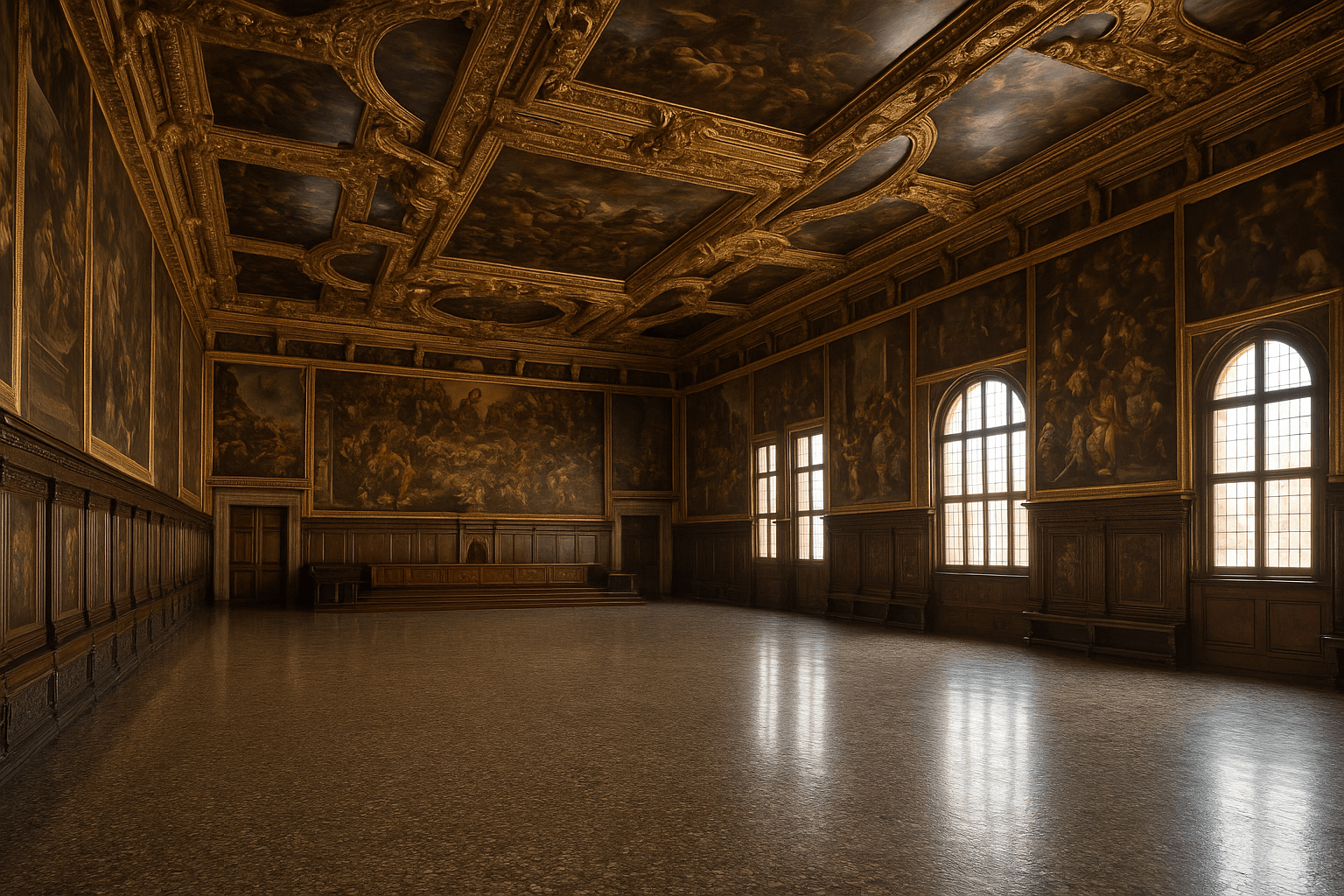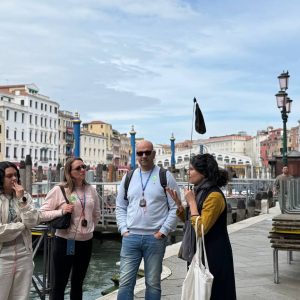Doge’s Palace Venice: History, Must-See Rooms and All the Artworks to Discover
- 9 min read
The Doge’s Palace Venice is one of the city’s most recognizable symbols, a place where art, power and history come together in a single path. Its Gothic façade catches the eye from afar, but it is inside that the palace reveals its complexity, because each room tells a chapter of the Serenissima. Due to its political and cultural importance, it is an essential stop for anyone who truly wants to understand Venice.


Doge's Palace: Guided Tour with Small Group and Skip-the-Line Ticket
Why Visit the Doge’s Palace Venice
Visiting the Doge’s Palace Venice means entering the political, artistic and symbolic heart of the Serenissima. This building was not only the Doge’s residence — it was also the administrative and judicial center of the Republic. Due to its crucial role in Venetian history, it is now one of the most fascinating museums in Italy, housing unique masterpieces, iconic rooms and secret passages that recount centuries of power.
Its exterior architecture, with the Gothic façade overlooking the lagoon, is already a masterpiece. But it is inside that the palace reveals its true grandeur: immense halls, sculptures, frescoes, political and allegorical artworks, the Scala dei Giganti, and the celebrated Sala del Maggior Consiglio. In summary, the Doge’s Palace Venice is a must-see for anyone seeking to understand the city’s identity and history.
Where It Is and How to Visit
The Doge’s Palace Venice faces St. Mark’s Square, next to the Basilica. The entrance is well marked and security checks are quick, but during the busiest months it is advisable to arrive a little earlier to avoid queues caused by the heavy flow of visitors.
A standard visit lasts from 1 to 2 hours, but those who want to explore more calmly can easily spend half a day, because every room contains details and artworks worth special attention. Due to the richness of the itinerary, it is advisable to follow the path in order — starting from the Courtyard, then visiting the Doge’s Apartments and finally moving on to the institutional rooms.
History of the Doge’s Palace Venice
The history of the Doge’s Palace Venice is long and complex. The first structure dates back to the 9th century, but the building we see today is the result of reconstructions and expansions mostly carried out between the 14th and 16th centuries. As the Republic kept expanding, new spaces were needed for magistrates, assemblies and decision-making bodies.
Over the centuries, the palace has endured fires, renovations and updates. However, its function has always remained the same: representing the power and authority of the Serenissima. Due to the central role attributed to the building, the greatest Venetian artists — Titian, Tintoretto, Veronese — contributed to its decoration.
What to See Inside the Doge’s Palace Venice
The visit begins in the Courtyard, a scenic space hosting both Gothic and Renaissance structures. Here you find the famous Scala dei Giganti, where the Doge was crowned. Why here? Because it symbolically represented the transition from an ordinary citizen to the highest office of the State.
The statues of Mars and Neptune, sculpted by Sansovino, evoke Venice’s maritime and military authority. In summary, even in the courtyard you can already sense the magnitude of Venetian power.
The Doge’s Apartments
These were the Doge’s private rooms but also had a representative function. The rooms are richly frescoed and include allegorical artworks celebrating justice, prudence and the strength of the Republic.
Among the most notable:
- Sala degli Scarlatti
- Sala degli Stucchi
- Sala delle Udienze
Due to their political significance, these rooms were used not only as a residence but also for private meetings and ceremonies.
The Institutional Rooms
These are the true heart of the palace. Here the magistracies, councils and assemblies that governed Venice carried out their work. Why are these rooms essential? Because they show how the Republic functioned, with a system of shared powers and cross-checking authorities.
Sala del Maggior Consiglio
One of the largest halls in Europe. Here sat the assembly of nobles who made the Republic’s most important decisions. On the walls are works by Tintoretto, including the gigantic Paradise, considered one of the largest paintings on canvas in the world.
Sala dello Scrutinio
Dedicated to voting and political ceremonies. Unfortunately, many original artworks were lost in a fire, but the hall remains an architectural masterpiece.
Sala del Senato and the Council of Ten
Rooms that reveal the discreet yet pervasive power of the Republic. Due to their role of vigilance, some of the most sensitive decisions were made here.
The Armoury
The weapons collection showcases the military and naval strength of the Serenissima. Swords, armor, crossbows, firearms — a vast heritage. Why is this section important? Because it testifies to the dual nature of Venice: a mercantile city but also a maritime power.
The Prisons and the Bridge of Sighs
The path also leads to the old prisons, connected to the palace through the famous Bridge of Sighs. The name comes from the sighs of prisoners who glimpsed the lagoon for the last time before being locked away.
The prisons were divided into two levels:
- I Piombi (the Leads), hotter, located under the lead roof
- I Pozzi (the Wells), more humid and severe, on the lower level
Due to the harsh conditions, few survived long imprisonment. In summary, this passage is one of the most evocative parts of the visit.

Doge's Palace: Guided Tour with Small Group and Skip-the-Line Ticket
All the Artworks to See in the Doge’s Palace Venice
Works by Tintoretto
Tintoretto is the undisputed protagonist of the palace. Among the most important:
- Paradise (Sala del Maggior Consiglio)
- The Doge Presents Venice to the Redeemer
- The Glory of Doge Pasquale Cicogna
- Scenes from Venetian history
His canvases celebrate the divine and political power of the Republic.
Works by Veronese
Veronese enriched the palace with grand, theatrical works that highlight the magnificence of Venice:
- The Victory of Lepanto
- Allegory of Justice
- Triumphs and allegories in the institutional rooms
His luminous palette enhances the architecture of the palace.
Works by Titian
Titian is present with portraits of Doges and influential figures. Due to the painter’s enormous prestige, his paintings reinforced the Republic’s public image.
Sculptures by Sansovino
Sansovino enriched the palace with monumental sculptures such as:
- Mars
- Neptune
- Decorations of the Scala dei Giganti
These works underline Venice’s maritime role.
Minor Artworks, Maps and Weapons
In addition to major masterpieces, the palace contains:
- Dogal coats of arms
- Maps of the Republic
- Portraits of magistrates
- Wooden panels and stuccoes
- Historical weapons and Venetian armor
In summary, every corner of the Doge’s Palace Venice tells a piece of history.
How Long Does It Take to Visit the Doge’s Palace Venice
The visit may last:
- 1 hour: quick tour
- 2 hours: standard complete visit
- 3 hours or more: in-depth exploration with guide or audio guide
Why does the duration vary? Because the palace is vast and filled with detailed rooms. Due to this complexity, many visitors choose to spend extra time in the Sala del Maggior Consiglio and the Doge’s Apartments.
Practical Tips for Visiting the Doge’s Palace Venice
Best Time to Visit
The ideal time to enter the Doge’s Palace Venice is early morning, because access is smoother and rooms are less crowded. The first hours of the day allow you to move calmly, but late afternoon can also offer a pleasantly quieter atmosphere. Due to variable attendance, choosing a non-central time of day helps enjoy the larger rooms — like the Sala del Maggior Consiglio — without crowds.
How to Avoid Queues
To save time, it is essential to buy tickets online before arrival, as ticket-office lines can become significant during peak season. It is also advisable to consider the Venice City Pass, especially in high season, because it grants skip-the-line access to the Doge’s Palace and includes other attractions. In summary, booking in advance is the most efficient choice.
Recommended Clothing
The rooms of the palace have variable temperatures due to the historic structure and the large size of the halls. For this reason, it is best to dress in layers, with comfortable, adjustable clothing. Comfortable shoes are essential because the route is long and includes stairs, corridors and ancient floors that can be slippery on humid days. In summary, practical clothing ensures a more pleasant visit.
Photography
Photography is allowed, but only without flash, as strong light could damage some artworks. It is always appropriate to follow staff instructions, as some areas have stricter photography rules. In summary, you can capture many spaces while respecting the artistic heritage and other visitors.

Doge's Palace: Guided Tour with Small Group and Skip-the-Line Ticket
FAQ – Doge’s Palace Venice
1. What is inside the Doge’s Palace in Venice?
Institutional rooms, Doge’s Apartments, works by Tintoretto, Veronese and Titian, the Scala dei Giganti, the Armoury and the prisons with the Bridge of Sighs. In summary, it is a complete historical and artistic museum.
2. How long does it take to visit the Doge’s Palace?
On average 1.5–2 hours, but an in-depth visit can take 3 hours.
3. Which museums are free in Venice?
Some churches and foundations offer free entry, but the Doge’s Palace Venice is always paid.
4. How much does it cost to visit the Doge’s Palace?
The price varies depending on the season. With the Venice Visit Pass or Venice City Pass, it is often included.
5. Why is the Doge’s Palace famous?
Because it represents the political history of the Serenissima and houses some of the most important artworks of the Venetian Renaissance.
6. What is the most beautiful place in Venice?
It is subjective, but many consider Doge’s Palace Venice one of the city’s most scenic places.
7. Is the Doge’s Palace worth it?
Absolutely, because of its history, artistic collection and unique architecture.
8. What should you see in Venice in one day?
St. Mark’s Square, Basilica, Doge’s Palace, Rialto Bridge, Grand Canal and a gondola ride.
